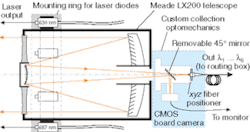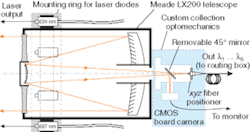Laser ranger measures to 17 km
Two-dimensional images of a 3-D world leave many unanswered questions. Image processing designed to extract 3-D information from a 2-D image can be misled by the color and reflectivity of objects, and by the direction of the sunlight falling on them. And so a new application of a technique that can give genuinely 3-D measurements over ranges from a few meters to 17 km, either from the air or on land, has received considerable interest. Development work at Heriot Watt University (Edinburgh, Scotland) is now being undertaken jointly with Qinetiq (Malvern, England).
The laser-ranging system uses a time-of-flight (TOF) sensor, based on time-correlated single-photon counting. It uses laser diodes at six wavelengths to locate and interpret signals from the surfaces of uncooperative distributed targets at distances from 1 to 17 km.
Led by Andrew Wallace and Gerald Buller, the Heriot Watt group has considerable experience in building TOF-based systems for generating 3-D profiles of smaller, closer targets. These have been used in applications such as industrial metrology and for reverse engineering in the aerospace industry, notably in the ranging system developed in the late 1990s with BAE Systems (Bristol, England). The principle of the systems for long-distance and closer 3-D imaging is similar. Short-pulse lasers are directed at the target and a sensitive detection system measures the round-trip time of photons reflected from its surface. Time-of-flight data is converted into distance measurement.
A commercially available 200-mm-diameter-aperture Schmidt-Cassegrain telescope is at the optical heart of the new long-distance system (see figure). A camera with a removable 45° mirror is used to direct the telescope and laser beams onto a distant target. The six pulsed laser diodes are mounted at 60° intervals around the circumference of the telescope with their light directed along its collection axis. The six emission wavelengths used are 630, 686, 780, 841, 911, and 975 nm; they were chosen to provide a range of wavelengths to characterize the target surface and also to avoid resonances with the expected molecular-absorption bands in the atmosphere. To get a measurable return signal over a range of tens of kilometers, it is important that very little of the diode light be absorbed by the air on the outgoing and return trips. To operate the system, a laser-driver sequencer triggers the six lasers independently and in sequence, each laser operating at a pulse-repetition rate of one-sixth of the trigger rate, which is typically around 20 MHz.
As the system must be usable in daylight, another important criterion is to minimize the solar background that would otherwise show itself as a high background level on the signal. The reflected signal collected by the telescope is focused onto an optical fiber positioned in the image plane. The fiber-core diameter that showed the best achievable signal with minimal solar background was in the range of 10 to 50 µm. A 50-µm fiber-core diameter was chosen for ease of alignment and to mitigate the effect of turbulence in the focal plane of the telescope. This fiber was connected to the input port of a diffraction grating–based optical-routing module. The router took the six-wavelength output from the fiber and spatially demultiplexed it into six separate fibers, one for each wavelength channel.
The return signal in each channel is small. When taking round-trip measurements at distances beyond 1 km, there are losses due to beam scatter as well as atmospheric loss, and there is also noise from scintillation caused by air turbulence. This means that careful signal processing—extracting small signals from noisy backgrounds—is key.
"We have been able to use the multispectral system to provide information about the range, and spatial and spectral distribution of a target," says Wallace. "We have evaluated the system response using corner cubes, and have measured uncooperative targets in the range of 200 m to 17 km, including distributed targets with effectively more than one target surface. We are exploring the application of a target-location-and-recognition system in which data received from the object is mapped into a 3-D image and compared with an existing 'library' of 3-D target models to match geometry and identify the specific object."

